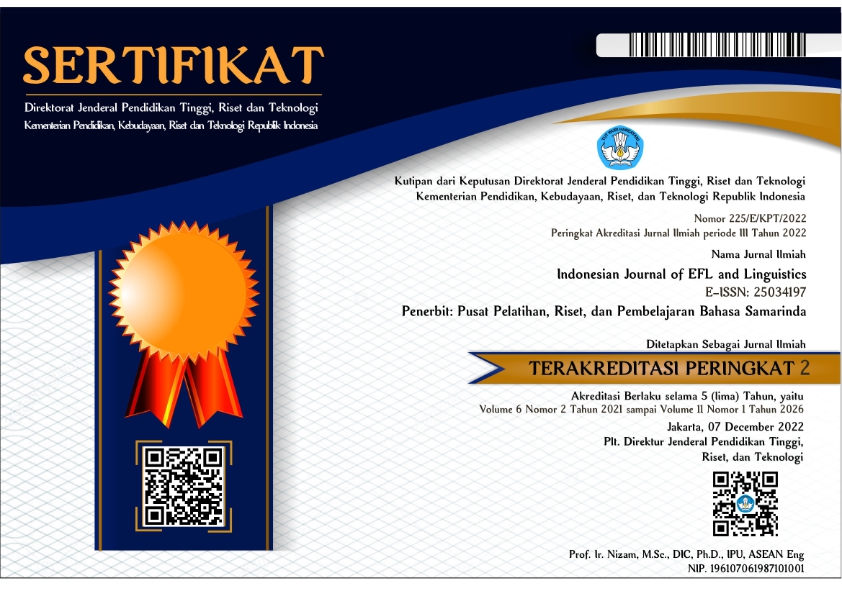Interactional Strategies and Anaphoric Repairs of BS Information and Communications (BSIT) Technology Students
Abstract
This study aimed to analyze the interactional strategies and anaphoric repairs used in the recorded pair conversations of the Bachelor of Science in Information and Communication Technology (ICT) students who were taking the course ICT 135 (Interactive English). The present research analyzed the ten recorded pair conversations. The results revealed the questions, minimal responses, and making statements predominated among the interactional strategies while the anaphoric repairs included other-initiated self-repair and self-initiated other-repair. This study provides implications to classroom interaction and use of language in interacting with other students. Future researchers can let their participants use their Mother Tongue or the Cebuano language as the language to be used in their research, regardless of the subject taken up by the participants. In using the Mother Tongue, the participants would be more comfortable in speaking providing a more natural and unrestricted flow of conversation.
References
Bennet, M. & Jarvis, J. (1991) Communicative function of minimal responses in everyday conversation. Retrieved July 11, 2015 from http://content.ebscohost.com/pdf14_16/pdf/1991/JSY/01Aug91/9707140321.pdf?T=P&P=AN&K=9707140321&S=R&D=a9h&EbscoContent=dGJyMNXb4kSep684yOvqOLCmr0qeprdSrqm4TLWWxWXS&ContentCustomer=dGJyMPGqsUy0prVLubm%2Fa7nb5ofx6gAA.
Bonvillian, N. (2003). Language, communication and culture: The meaning of messages (4th Ed.). New Jersey: Pearson Education, Inc.
Chan, N. (2008). Gender stereotypes: a sociolinguistic study ofthe amazing race asia season twoâ€. Retrieved December 06, 2015 from http://www.english.hku.hk/LCOM%20paper/LCOM%20papers%20new,%20rev/2008%20vol2/4%20Gender%20stereotypes.pdf
Coates, J. (2004). Women, men and language: a sociolinguistic account of gender differences in language (3rd Ed.). UK : Pearson
Coupland, N. & Jaworski, A. (1997).Modern linguistics: sociolinguistics – a reader and a coursebook. New York: St. Martin’s Press, Inc.
Hennoste, T. (2005). Repair-initiating particles and um-s in Estonian spontaneous speech. Retrieved September 27, 2015, from http://www.isca-speech.org/archive_open/archive_papers/diss_05/dis5_083.pdf
Gumperz, J. (2008). Interactional sociolinguistics: a personal perspective. Retrieved October 12, 2015 from http://www.maxwell.syr.edu/uploadedFiles/exed/sites/ldf/Academic/Gumperz.pdf
Hosoda, Y. (2000). Other-Repair in Japanese Conversations between Nonnative and Native Speakers. Retrieved September 27, 2015, from http://www.escholarship.org/uc/item/9rb6b1m6
Huang, Y. (1989). Discourse anaphora: Four theoretical models. Journal of Pragmatics. 32, 151-176.
McCarthy, M. (2003).Talking back: “small†interactional response tokens in everyday conversation. Retrieved July 10, 2015 from http://www.cs.cmu.edu/afs/cs.cmu.edu/Web/People/dod/papers/mccarthy2003.pdf
Mesthrie, R., Swann, J., Deumert, A. & Leap, W. (2000) Introducing sociolinguistics (2nd Ed.). New York: Edinburgh University Press.
Norrick, N. (2008). Negotiating the reception of stories in conversation: teller strategies for modulating response. Retrieved December 06, 2012 from http://benjamins.com/series/ni/18-1/art/07nor.pdf
Parkson, S. (2007). Other-initiated repair acts. Preventing and Detecting Miscommunication: Analysis of Estonian Information Dialogues. Retrieved September 27, 2012, from http://www.speech.kth.se/~rolf/NGSLT/gslt_papers_2006/TermPaperParkson.pdf
Pearson, J., Nelson, P., Titsworth, S., & Harter, L. (2003). Human communication. New York: McGraw-Hill.
Redeker, G. (2006). Gendered interaction strategies in televised panel interviews. Retrieved July 10, 2012 from http://www.let.rug.nl/redeker/RedekerSocioling2006.pdfll
Schegloff, E., Jefferson, G., & Sacks, H. (1977). The preference for self-correction in The organization of repair in conversation. Retrieved January 22, 2013 from http://www.liso.ucsb.edu/Jefferson/Repair.pdf
Sidnell, J. (2010). Conversational analysis: an introduction. United Kingdom: Wiley-Blackwell
Sidnell, J. (Ed.).(2009). Conversational analysis: comparative perspectives. New York: Cambridge University Press.
Smith, B. (2008). Methodological Hurdles in Capturing CMC data: The Case of the Missing Self-Repair. Retrieved September 27, 2012, from http://llt.msu.edu/vol12num1/pdf/smith.pdf
Stockwell, P. (2007). Sociolinguistics: a resource book for students (2nd Ed.). New York: Routledge.
Tannen, D. (2005). Interactional sociolinguistics as a resource for intercultural pragmatics. Retrieved October 12, 2012 from http://www9.georgetown.edu/faculty/tannend/pdfs/interactional_socioling_as_a_reource_for_intercultyral_interaction.pdf
Wardhaugh, R. (2010). An introduction to sociolinguistics (6th Ed.).United Kingdom: Wiley-Blackwell




